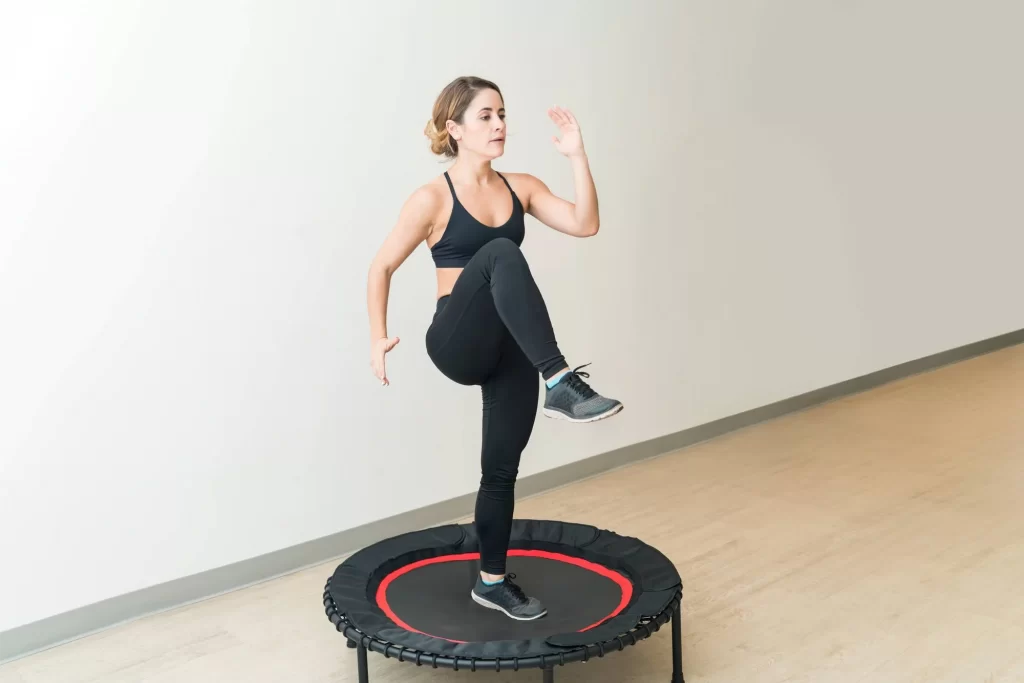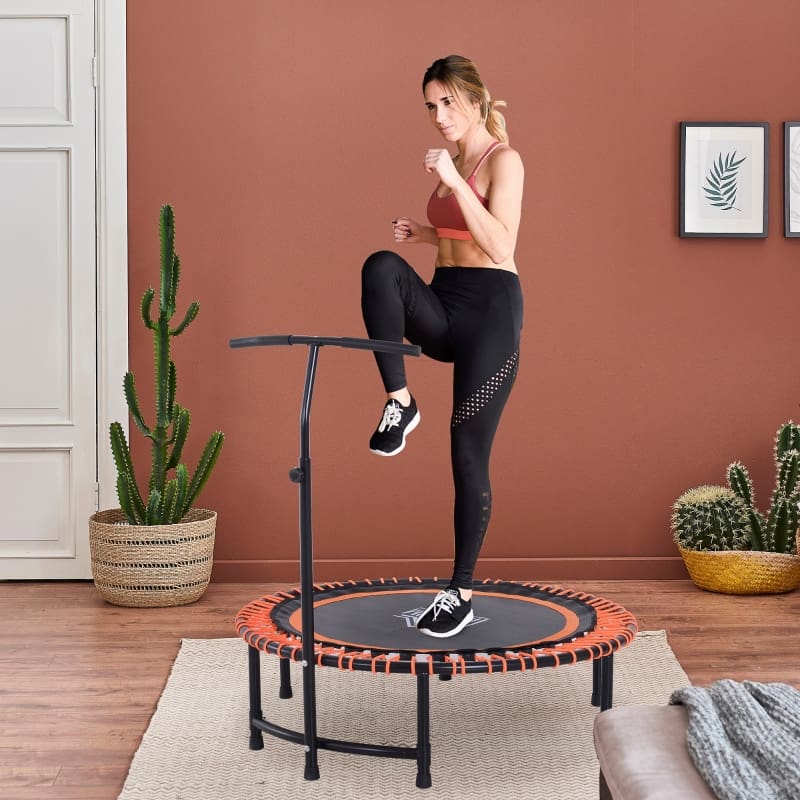Can You Use a Rebounder Upstairs?
If you live in an apartment or don’t have an exercise space on the ground floor of your house, you might be wondering, can you use a rebounder upstairs? Yes you can use a rebounder upstairs, while it’s physically possible, there are some considerations to doing so. If you’re shopping around for the best rebounders, check out our comparison article.
We cover them in this article, along with a few brief tips on how to reduce the noise level.
Ready to start your rebounder weight loss journey? Try out our 8-week rebounder program!

Can You Use a Mini Trampoline Upstairs?
You can use a mini trampoline on the upstairs floor of a building. Of course, you’ll need to make accommodations depending on who’s downstairs, as the bouncing action of a mini trampoline can create a lot of noise.
If it’s your own house, there’s very little you need to worry about. Whether you live alone or with family or friends, all you’ll need to do is let them know you’re using it.
The benefit of living in the same home is that they can tell you if your rebounder is being too loud.
However, if you live in a flat above a neighbour, it’s worth taking some steps to either pre-empt the amount of noise you’ll make or reduce the amount that transmits through the building.
Here is my recommendation on the quietest rebounder you can buy:
- 💪400 lbs REBOUNDER TRAMPOLINE for ADULT – Top mini trampoline choice among ADULTS fitness pros users for rebounding exercise, weight losing, body shaping and any rebounder exercise
- 💪400 lbs MAX-LOAD BUNGEES REBOUNDER(0.32″dia.) for QUIET, SAFELY, SOFT but HIGHER Bounce – 3rd generation bungees, mega strong and perfect tension, provides Safer and Quieter bounce back, reduces noise in maximum extent.
- 💪EXERCISE TRAMPOLINE made of Heavy Duty Steel And 6 Legs Frame provides unmatched stability and won’t tip over for added safety; From balance exercises to high intensity training, it’s designed to help you to reach your fitness goals.
Last update on 2024-07-26 / Affiliate links / Images from Amazon Product Advertising API
Why Do Rebounders Make Noise?
The first thing worth discussing, though, is why rebounders make noise. It might seem like an obvious question to answer, but digging into it will help you understand how you can reduce the level of noise it makes.
We can divide all forms of noise into 2 broad categories: impact and airborne. Airborne noise is, unsurprisingly, a sound that travels through the air from the source to your ears.

Common examples of this include people talking or the sound of a TV. Airborne sounds can travel through walls or floors, but we still consider them to be airborne.
Impact sounds, on the other hand, happen when an object makes contact with a surface. It creates vibrations that pass through the surface and come out the other side as sounds. Noises are vibrations, after all, whether these are vibrations in the air or an object.
Examples of impact sounds include someone walking on a floor, moving furniture, or, you guessed it, a rebounder. You bouncing up and down on the mini trampoline creates vibrations as a reaction to your movement, which transmit into the floor and pass into the rooms below.
Sure, rebounders will also make airborne noises, such as the springs moving, but impact noise is by far the bigger issue. Knowing the difference between impact and airborne sounds will help you reduce the amount of noise your rebounder makes.
Can a Rebounder Be Used on Carpet?
A rebounder can be used on any surface, but something like carpet is preferable. It’s because carpet is a soft surface, so it helps reduce the amount of vibrations that transmit into the floor. Rugs and other soft materials work fine, too.
We can again get fairly technical to explain this, but there’s no real need. Instead, let’s go over a brief definition of soundproofing.
Soundproofing is, unsurprisingly, the practice of reducing or blocking sounds. It’s a bit of a misnomer because it doesn’t always involve proofing a space from sound. A big area of soundproofing is reducing the transmission of sound waves, so they’re less powerful.

Again, without getting too technical, there are 4 main principles of soundproofing. The one we’re interested in here is dampening. It simply involves reducing the intensity of sound vibrations.
To do so, your best bet is to use soft materials, as they don’t vibrate as easily as hard ones. As such, carpet is a great way to dampen impact sounds before they transmit into the floor.
Carpet also provides a small amount of sound absorption, which is important for airborne sounds. It’s again because carpet is soft, so sound waves can’t bounce off it. The bottom line is that if you’re going to use a rebounder upstairs, carpet is one of the best floor surfaces for it.
What Do You Put Under a Mini Trampoline?
When using a mini trampoline upstairs, you should put soft materials under it. As mentioned, this helps to dampen the vibrations bouncing causes before they reach the floor. While it won’t completely cancel out the noise, it should do a decent job of cutting it down.
What sort of soft materials can we use? Well, some of the following work:
· Carpet
· Rug
· Blankets
· Rubber mats
· Gym mats – Like this one below which is specifically designed for gym equipment:
Some materials are obviously more effective than others. Ideally, your material should be fairly thick, as this’ll do a better job of dampening the vibrations.
Whatever you choose, ensure it’s flat and stable otherwise your rebounder could move, causing an injury. Using a rebounder safely is always more important than reducing noise levels.
Mat for Under Rebounder
There are plenty of materials you can choose for a mat to go under your rebounder. It should be soft and flexible but with decent stability. If you were to use something thick, ensure your rebounder doesn’t move when you bounce on it.
One of the best options is EVA foam tiles, such as those you might see in a gym. There’s a reason gyms use them, and it’s not just related to safety. Foam tiles are great for dampening sound waves, which is useful in a gym. Check them out here:
You can buy packs of interlocking EVA foam tiles. They’re a better option for larger spaces, as they’re more secure than individual tiles. While you shouldn’t need more than one for a rebounder, it can’t hurt to lay a few down.
Failing that, silicone or any other type of dense foam will also do the job.
Mini Trampoline Upstairs Apartment
If you have live in an upstairs apartment consider putting something underneath the rebounder to stop it from sliding around and making additional noise through impact. Your neighbours below will thank you for it!
Hopefully, you’ve now got some useful information about using a rebounder upstairs. Along with using some preventative measures, it’s always best to let your neighbour know you’ll be using your rebounder and to only use it at acceptable times. After all, no one wants to be woken up by you rebounding at 2am!
An ex-triathlete, fitness coach and writer with a Masters in Sports Physiology. Fitness is my passion and I've had my fair share of home fitness equipment tried and tested!





